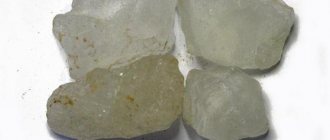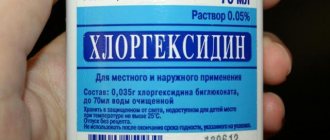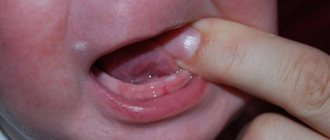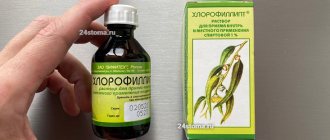What is burnt alum
Burnt alum is a powdery substance that is obtained by heating a potassium-aluminum compound. After heat treatment, the substance is ground and sieved to isolate the hygroscopic powder. Burnt alum is white, odorless, and has a sour-astringent taste. Natural origin allows you to exclude perfume components, fragrances and artificially synthesized substances from the composition.
You can buy burnt alum in 50 g plastic jars. The instructions indicate that the product is intended for external use. It does not completely dissolve in water and tends to clump when left in the open air.
Manufacturers indicate only 100% crystalline powder of potassium alum in the composition.
Description
Burnt alum is a unique substance created on the basis of traditional potassium aluminum samples. To obtain them, the starting material is heated to 160 degrees Celsius, after which it is evaporated until 50% of the original volume is lost.
As a result, it is possible to obtain an absorbent, odorless, white powder, distinguished by its shape in the form of small crystals.
The finished product has the following effect:
- antibacterial;
- drying;
- hemostatic;
- cauterizing;
- enveloping.
In addition, alum quickly eliminates itching and other discomfort. As a result, help with stomatitis is guaranteed in every case.
How burnt alum works
When applied topically, the powder acts in several ways:
- relieves inflammation and disinfects;
- dries;
- relieves itching;
- prevents and eliminates unpleasant odors.
The substance does not irritate the skin at the site of application. After application, it forms a colloidal film that envelops the nerve endings. It relieves pain, itching and burning sensations, and discomfort from insect bites.
In what cases will burnt alum help?
According to the instructions for the drug, burnt alum is used in:
- combating excessive sweating. The ability to adsorb moisture and reduce the functioning of glands that secrete sweat and sebum is actively used by patients with hyperhidrosis. In addition, alum is able to disinfect areas with excessive sweating and get rid of bacteria and fungi that are sources of unpleasant odors; can be used as an antiperspirant;
- prevention of skin irritations, for treating minor scratches, including after using a razor;
- therapy of dermatological pathologies: dermatitis, diaper rash, eczema, neurodermatitis, fungal infections of the feet;
- gynecology and urology – for the treatment of vulvovaginitis, balanitis;
- dentistry - for the treatment of gingivitis, stomatitis;
- cosmetology - to narrow pores, increase elasticity, relieve inflammation. Added to powder or cream.
Burnt alum powder can be used to treat festering wounds and trophic ulcerations on the skin. As a result, the damaged surface of the skin will dry out and tighten, and bleeding will stop.
Stomatitis
Cold
HIV
Fungus
Scarlet fever
Gastritis
11928 September 24
IMPORTANT!
The information in this section cannot be used for self-diagnosis and self-treatment.
In case of pain or other exacerbation of the disease, diagnostic tests should be prescribed only by the attending physician. To make a diagnosis and properly prescribe treatment, you should contact your doctor. Stomatitis: causes, symptoms, diagnosis and treatment methods.
Definition
Stomatitis is a collective name for diseases of the oral mucosa, manifested by its redness, swelling with the formation of areas of erosion, ulcers or blistering rashes. Stomatitis affects approximately 20% of the population, most often children. Stomatitis can be either an independent disease or a complication or manifestation of other diseases (for example, scarlet fever, influenza, measles, etc.).
Causes of stomatitis
There is no single factor that is the sole cause of oral inflammation. With stomatitis, bacteria or viruses are detected, especially in ulcers on the mucous membrane. However, a diverse microflora is always present in the oral cavity, but stomatitis makes itself felt only when there is a strong additional impact on this microflora.
These impacts include:
- trauma to the mucous membrane caused by overzealous brushing of teeth, rough food, etc.;
- decreased immunity due to colds, vitamin deficiencies, chronic diseases, stress, poor nutrition, as well as more serious diseases (anemia, cancer and autoimmune diseases, HIV);
- entry of a large number of pathogenic microorganisms into the oral cavity through dirty hands, unwashed foods, etc.;
- conditions for the proliferation of pathogenic microflora due to the presence of caries, tartar and plaque, lack of proper teeth cleaning, etc.;
- uncontrolled use of drugs that affect the quantity and quality of saliva and reduce its antimicrobial potential;
- inhibition of normal microflora by antibiotics;
- dehydration of the body with a decrease in the amount of saliva;
- diseases of the gastrointestinal tract (gastritis, pancreatitis, etc.).
Classification of the disease
Due to its occurrence:
- traumatic stomatitis
occurs as a result of the influence of physical (wound, burn from hot food, etc.) or chemical (burn of the oral mucosa with caustic substances, etc.) factors on the mucous membrane; - infectious stomatitis
occurs as a result of a viral, bacterial or fungal infection; - specific stomatitis
occurs as a result of a specific infection (tuberculosis, syphilis); this group includes radiation, drug, and stomatitis due to occupational diseases; - symptomatic stomatitis
develops against the background of diseases of the gastrointestinal tract, cardiovascular, nervous, endocrine systems, and blood diseases; - allergic stomatitis
develops upon contact with allergens.
According to the clinical picture:
- catarrhal stomatitis;
- ulcerative stomatitis;
- aphthous stomatitis.
With the flow:
- spicy;
- chronic.
There are stomatitis associated with dental problems - for example, denture stomatitis occurs due to damage to the mucous membrane by dental structures, due to poor care of removable dentures, and the patient’s failure to comply with oral hygiene.
Symptoms of stomatitis
In children, the disease is more severe than in adults: body temperature may rise significantly and intoxication may be present.
In adults, oral stomatitis, as a rule, is not accompanied by fever, except in cases of deep damage to the mucous membranes in the ulcerative form of the disease.
The most common is catarrhal stomatitis, which is characterized by inflammation of the oral mucosa without the formation of deep defects (ulcers). For those around you, catarrhal stomatitis manifests itself as “stale breath”, for the patient himself – pain, swelling and redness of the mucous membrane. Gingival papillae are easily injured and bleed.
In persons with pathologies of the gastrointestinal tract, as well as with inadequate treatment, catarrhal stomatitis tends to progress to the next stage - ulcerative with the formation of defects throughout the entire depth of the mucous membrane. It is accompanied by an unpleasant odor from the mouth, even putrefactive, the ulcers are covered with a gray coating, and eating any food leads to increased pain. Ulcerative stomatitis is more severe than catarrhal stomatitis and can cause a slight increase in temperature and enlargement of regional lymph nodes.
Aphthous stomatitis manifests itself in the form of small (3-5 mm) single or multiple defects of the mucous membrane of an oval or round shape, surrounded by a thin bright red border and covered with a yellow-gray fibrin coating. Aphthae do not form simultaneously, so you can see different stages of their development. Healing of aphthae begins after the fibrin plaque peels off on its own and ends with the complete disappearance of the defect.
Allergic stomatitis in the mouth occurs against the background of an exacerbation of the underlying disease - allergies. Increased sensitivity of the body can occur to food, medications, pollen, animal hair, cosmetics and care products, and even clothing. Most often, stomatitis is provoked by toothpastes that contain flavorings and chemical components.
Among viral stomatitis, the most common is herpetic stomatitis, which worsens against the background of ARVI. The disease begins with general malaise and lasts 7-10 days.
The oral mucosa becomes red and swollen, and regional lymph nodes become enlarged. After a few days, a blistering rash appears on the tongue and inner surface of the cheeks, and inside the rash there is a translucent liquid. After the bubbles open, small erosions appear, which are covered with a yellowish film.
Diagnosis of the disease
Adequate treatment of stomatitis can be prescribed by determining what caused it - bacteria, fungi or viruses.
If a fungal infection is suspected and to assess the effectiveness of therapy,
Candida albicans
in an oropharyngeal scraping and culture is performed for yeast-like fungi of the genus
Candida
and
Cryptococcus to determine sensitivity to antifungal drugs.
How to use burnt alum powder
The manufacturer prescribes the use of the drug, if indicated, externally as a powder; the frequency of administration is not limited.
Wounds and ulcers are treated with a solution of powder. To prepare, take ½ teaspoon of the substance and add to 200 ml of hot water. The composition is applied to the wound surfaces the required number of times; a gauze bandage may be applied.
When used simultaneously with other drugs, the powder does not react with them.
Instructions for use
Alum is used as a mouth rinse for stomatitis.
To prepare the solution, add 0.5 tsp to a glass of boiled water. powder and stir it thoroughly.
In this case, the consistency of the solution becomes slightly viscous (like laundry starch), and the taste becomes sour. Should be used 5-7 rubles/day, duration of procedure is 1-2 minutes.
The use of the solution for the treatment of stomatitis in children is not prohibited, but the application pattern is modified: it is necessary to lubricate the oral cavity with a cotton swab 3-4 times a day and for 30-40 minutes. After the procedure, refrain from eating and drinking.
Recipes
A remedy to combat armpit sweating. To prevent the white powder from crumbling during application and to ensure that the composition gets directly onto the skin, it is better to prepare the composition:
- dissolve two teaspoons of burnt alum in 500 ml;
- add a few drops of essential oil with your favorite scent;
- pour the solution into a bottle equipped with a sprayer.
At first, the product must be used twice a day, then the composition can be applied to the armpit area once a day.
- For sweaty feet. In this case, dry alum is used. First you need to clean your feet with a pumice stone or a scraper. Then the surface is treated with alum. To enhance the effect, you can treat socks and shoes that are worn every day with alum. Already on the third day, sweat production decreases, cracks in the legs heal, and small wounds heal. To prevent the skin from drying out, the skin of the feet can be treated with cream.
- Face mask for enlarged pores. Ingredients you will need: one egg white, 5 grams of burnt alum powder, one teaspoon of almond or apricot oil. The protein must first be whipped into a foam, add other ingredients and mix. Apply to clean skin for half an hour. Then wash off with warm water.
Lotions, rinses
The rinse solution is prepared as follows:
- take the following ingredients: a glass of boiled water, 4-5 g of burnt alum;
- mixing until the crystals are completely dissolved;
- store the solution for no more than two days in the refrigerator;
- The liquid must be stirred before use.
To cure stomatitis in a child, you can use the method of spot treatment of ulcers with a concentrated solution.
To obtain the working fluid, you need to take 10 g of alum per glass of water. The solution is applied using cotton pads and rubbing.
The resulting solution should be used every 3 hours by rinsing. Afterwards it is recommended to treat the ulcers locally.
Reviews
According to customer reviews, burnt alum works well in treating skin problems, including complex wounds with suppuration and trophic ulcers.
However, the powder is mainly used in the fight against sweating and its consequences; it is applied instead of deodorant to the armpits, on the feet and palms, and in shoes to prevent unpleasant odors. The downside is that it stains clothes when applied.
Some buyers note that alum does not help overcome excessive sweating, but an unpleasant odor does not appear after application.











